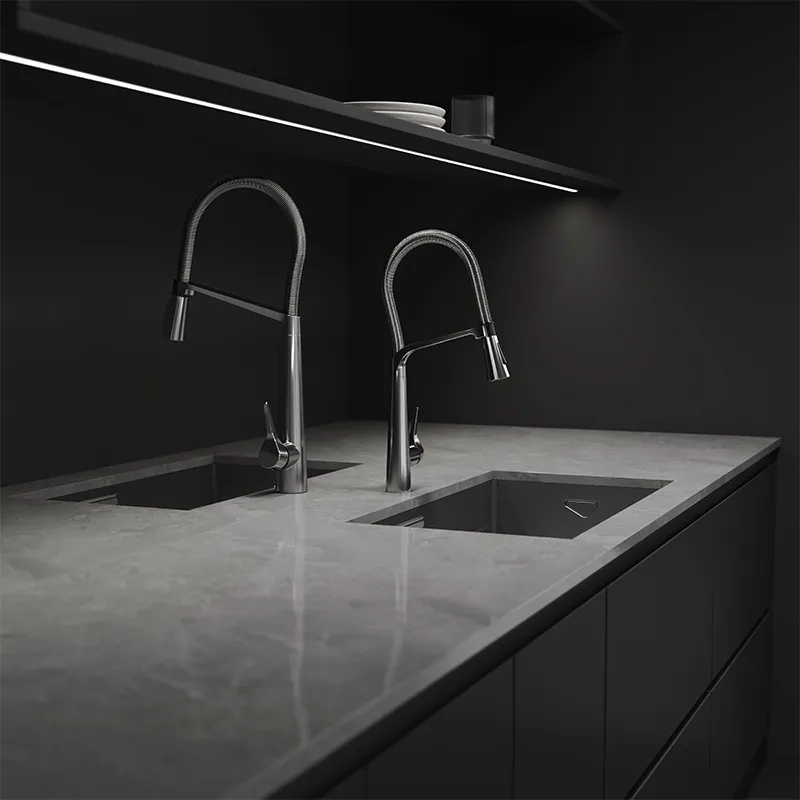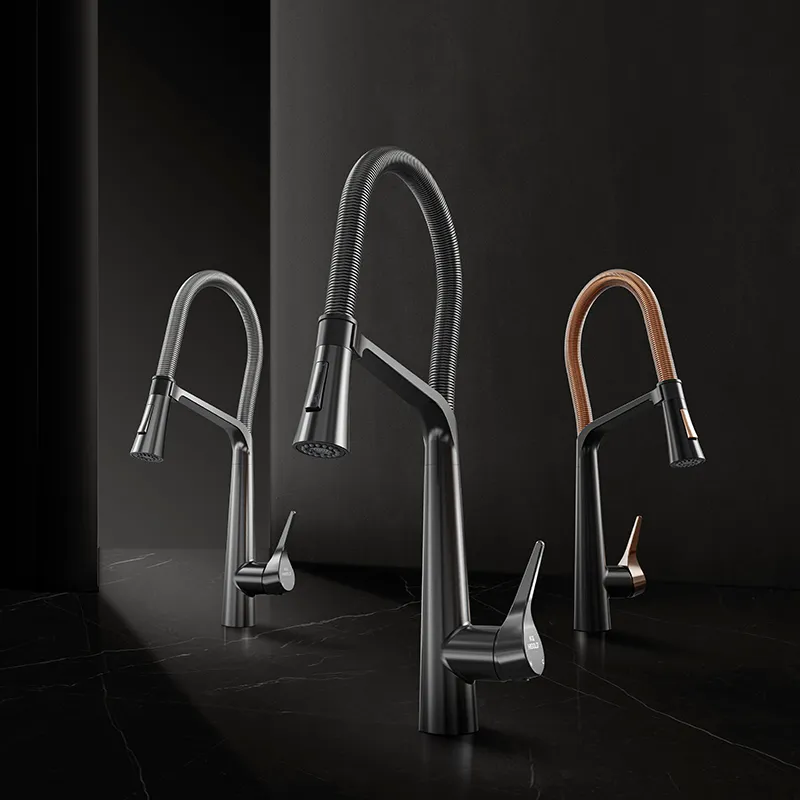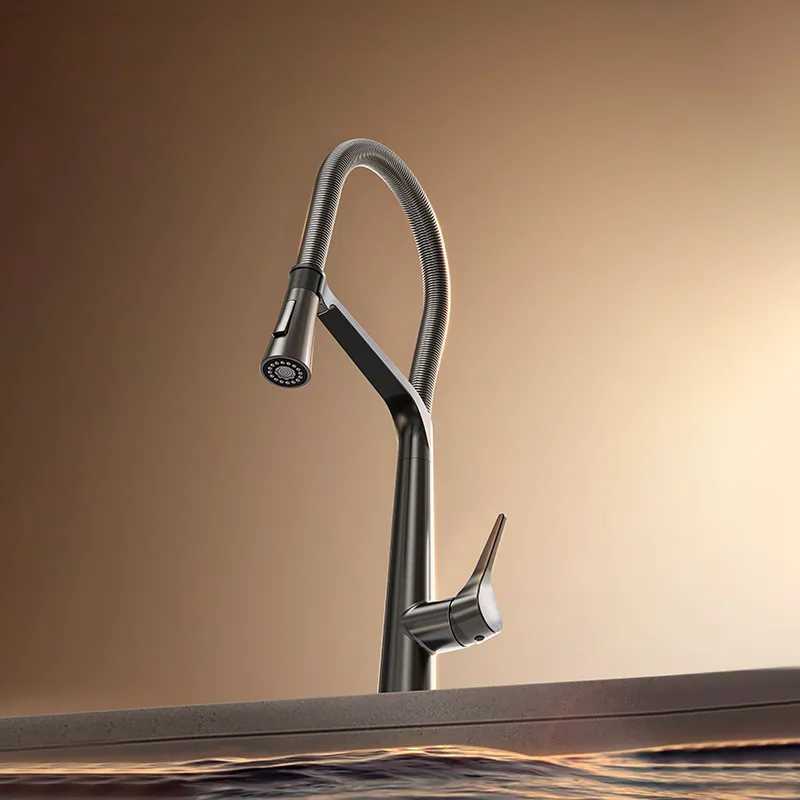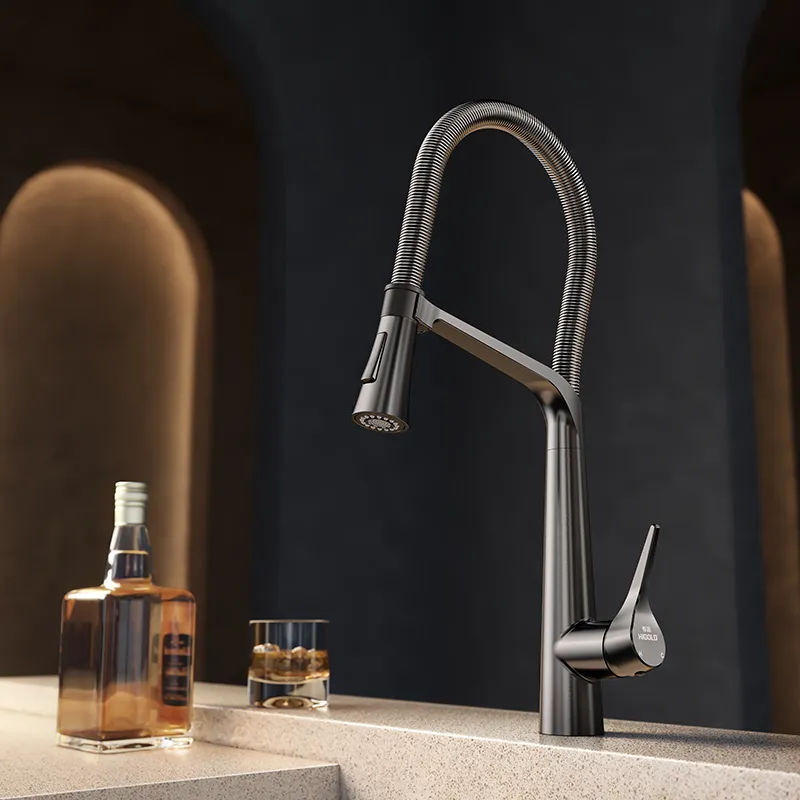In modern kitchen and bathroom renovations, hot and cold sink faucets have become an essential component. Compared to traditional single-spout faucets, hot and cold sink faucets not only offer the flexibility to switch between hot and cold water, but also allow for mixed water flows of varying temperatures by adjusting the direction of rotation.
However, in actual use, many consumers often raise the same question: Do hot and cold sink faucets rotate in the same direction? This seemingly minor question is crucial to daily convenience and safety, and even to the development of international standards.

The Origin of the Hot and Cold Sink Faucet Rotation Direction Issue
Hot and cold sink faucets typically consist of a valve core, a handle, an inlet, and an outlet. The valve core is a key component, controlling the ratio of hot and cold water by rotating or pulling. When the user rotates the handle, the internal valve core opens and closes at a different angle, switching between cold, hot, or mixed water.
In this process, the design of the rotation direction is influenced not only by ergonomic considerations but also by national customs and regulations. For example, some regions customarily turn the faucet left for hot water and right for cold water; in other regions, the reverse may be true. This is precisely why the direction of hot and cold water faucets can cause controversy and confusion.
Are hot and cold water faucets oriented in the same direction?
The most common consumer question: Do hot and cold water faucets all turn in the same direction? The answer is—not exactly. There are even regional and product variations.
1. Common Design Patterns
On most hot and cold water faucets, turning left turns hot water, and turning right turns cold water. This is the most common direction setting on the market.
Some hot and cold water faucets are designed to push and pull forward: push forward for cold water, pull back for hot water. The direction of rotation is primarily used to control the amount of water.
2. Standard vs. Non-standard Designs
In Europe, North America, and some Asian countries, industry standards clearly stipulate the direction of hot and cold water faucets: left for hot, right for cold. This design aligns with the natural behavior of most people using their right hand.
However, some products use the opposite direction to meet special needs or user habits. For example, some custom hot and cold sink faucets have the right side set to hot water.
3. The Difference Between Single-Handle and Double-Handle Faucets
Single-handle hot and cold sink faucets: The rotation direction generally controls temperature left and right, and flow rate up and down.
Double-handle hot and cold sink faucets: The left handle controls hot water, and the right handle controls cold water, with completely different rotation directions.
Therefore, the rotation direction of hot and cold sink faucets is not standardized globally but is influenced by multiple factors, including design concepts, regional standards, and user habits.

What causes the difference in rotation direction between hot and cold sink faucets?
Why are there inconsistencies in the rotation direction of hot and cold sink faucets? The main reasons are as follows:
1. Ergonomics and User Ease
Manufacturers design the rotation direction of hot and cold sink faucets based on the fact that most people use their right hand. For example, turning the faucet to the left naturally adjusts the hot water setting, which aligns with daily usage.
2. International Standards and Regional Customs
National standards vary. For example, Europe widely adopts the standardized "hot on the left, cold on the right" standard, while some regions may use "hot on the right, cold on the left" due to plumbing layouts or historical customs. Hot and cold sink faucets often need to be adjusted to comply with local regulations when sold in different markets.
3. Differences in Installation Methods
In some cases, the installation method of hot and cold sink faucets may result in "reversed" direction. If the hot and cold pipes are connected incorrectly during installation, the rotation direction may not be as expected.
4. Product Variations
Single-handle, double-handle, and pull-out faucets vary in structure, making it difficult to maintain a completely consistent rotation direction.
Hot and Cold Sink Faucet Rotation Direction and User Experience
The differences in hot and cold sink faucet rotation direction are not only a design issue but also directly impact user experience and safety.
1. User Ease of Use
If the rotation direction of a hot and cold sink faucet aligns with the user's daily habits, it will be more convenient to use. Conversely, if the direction is unintuitive, users may need to frequently adjust the direction, or even make mistakes.
2. Safety
Improper rotation direction design can easily lead to accidentally turning on hot water, especially at high water temperatures, which can pose a risk of scalding. Clear and consistent rotation direction is particularly important for children and the elderly.
3. Learning Cost
In public places or short-term rental apartments, consumers often face unfamiliar rotation directions for hot and cold sink taps, requiring repeated attempts to find the correct water temperature, adding complexity to usage.

Common Consumer Misconceptions
When using hot and cold sink taps, consumers often fall into the following misconceptions:
1. Assuming the rotation direction is uniform worldwide
Many people assume that all hot and cold water faucets have the same rotation direction, but in reality, there are significant differences between regions, brands, and models.
2. Ignoring the Importance of Installation
If the hot and cold water pipes are connected incorrectly, the hot and cold water faucets will rotate in the opposite direction. This is not a product defect, but rather the result of improper installation.
3. Ignoring the markings due to the reckless use of cleaning agents
Hot and cold water faucets typically have a red and blue marking to indicate the rotation direction. Long-term use of strong acid or alkaline cleaning agents can corrode the markings, making it more difficult for users to determine the direction.
How to correctly identify and use the direction of hot and cold sink faucets?
To avoid misoperation, consumers should master certain identification and operation tips when using hot and cold sink faucets:
1. Observe the markings
Most hot and cold sink faucets have red and blue markings on the handles, with red representing hot water and blue representing cold water. This marking can help you determine the direction of rotation.
2. Gently test the water
When using a hot and cold sink taps for the first time, gently open it to feel the water temperature before gradually adjusting the direction of rotation. Avoid sudden, sudden changes.
3. Pay attention to the installation instructions
When installing a hot and cold sink taps, strictly follow the instructions to connect the pipes to the faucet to avoid connecting the hot and cold water pipes in the wrong direction.
4. Regularly inspect the valve core
A damaged valve core can cause insensitive hot and cold water switching, resulting in a mismatch between the direction of rotation and the water temperature. Regular maintenance of the valve core ensures consistent direction and temperature.

How can I extend the life of a hot and cold sink taps?
To ensure the hot and cold sink taps maintain their proper rotation direction and water flow over the long term, routine maintenance is essential:
1. Keep them clean
Use a mild, neutral detergent to clean the hot and cold sink taps to avoid damaging the markings or affecting the valve core's sensitivity.
2. Avoid forceful operation
Do not forcefully rotate the hot and cold sink tap handles to avoid damaging the valve core and causing inaccurate rotation.
3. Regularly maintain the valve core
Apply lubricant or replace the valve core to ensure smooth rotation and temperature switching.
4. Check the plumbing installation
Confirm that the hot and cold sink taps follow the standard water flow direction: hot on the left, cold on the right. If reversed, adjust the installation immediately.
Do hot and cold sink taps have the same rotation direction?
The answer is: not exactly. The rotation direction of hot and cold sink taps may vary across regions, brands, and designs. In most cases, the hot on the left, cold on the right is the most common direction, but improper installation or product variations can also cause reversed directions.
For consumers, correctly identifying the rotation direction of hot and cold sink taps and mastering scientific usage and maintenance methods not only improves operational convenience and safety but also extends the product's lifespan. For the industry, clear regulations and unified standards are also key to reducing confusion and ensuring a positive user experience.
What eco-friendly practices does Higold use in production?
Higold adopts environmentally responsible practices such as recycling stainless steel scraps, using energy-efficient machines, and reducing water consumption in manufacturing. The company also invests in smart systems that optimize production while minimizing waste.
Buyers with sustainability goals can promote Higold products as eco-conscious, which adds marketing value in regions where green purchasing is prioritized.


